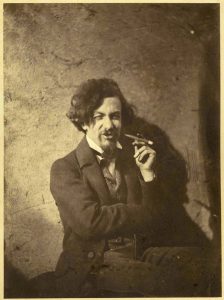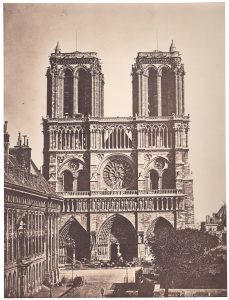Category: PHOTOGRAPHY
Le Gray is well known for his technical innovations and distinctive photographs as well as for his teaching of other notable photographers. His architectural, landscape and portrait photographs were influential and he was an important contributor to the development of the wax paper negative. In the 1850s the photographer started using collodion-on-glass negatives in preference to paper negatives in order to achieve increased sharpness of the image
and faster exposure times.
His students included Charles Nègre, Henri Le Secq, Nadar, Olympe Aguado, and Maxime Du Camp. In 1851, he became one of the first five photographers hired for the Missions Héliographiques to document French monuments and buildings. Despite his success, he became bankrupt in 1860. He left his life in France for travels in Italy, before settling in Egypt where he continued to take photographs.
Selected exhibitions:
2003
“Sea and Sky: Photographs by Gustave Le Gray 1856-1857”, Victoria and Albert Museum, London, UK
2002
“Gustave Le Gray, Photographer”, Getty Center, Los Angeles, USA
1999
“Museum as Muse: Artists Reflect”, Museum of Modern Art, New York, USA
1998
“Beyond the Edges: An Insider’s Look at Early Photographs”, The Metropolitan Museum of Art, New York, USA
1987
“The Photography of Gustave Le Gray”, Art Institute of Chicago, Chicago, USA

Bisson Frères
Louise-Auguste Bisson (1814-1876) was a 19th century French photographer. He opened a photographic studio in 1841 and soon after this he was joined as a partner by his brother Auguste-Rosalie Bisson (1826-1900). Together, these pioneering photographers became known as the Bisson Frères.
They were active during a rich time of photographic sponsorship and were able to develop processes for creating very large prints (such as the Collodion process, with large negatives) and for taking on important commercial projects. During the 1850s they employed up to thirty employees.
The Bisson brothers were members of the French Society of Photography. They travelled avidly, and a significant number of their many pictures were taken outside of French territory. They are perhaps best remembered for their series of photographs on the Savoy Alps, commissioned by Napoleon III in 1860.
The Bisson Frères also gained recognition for their wide range of photographic styles and for the best-known portrait of of Honoré de Balzac (1842).
Selected exhibitions:
2014
“Impressionist France: Visions of Nation from Le Gray to Monet”, Saint Louis Art Museum,
Saint Louis, USA
2007
“Johnson Gallery, Selections from the Collection 44”, The Metropolitan Museum of Art, New York, USA
2005
“Master Photographs from the Gilman Collection: A Landmark Acquisition”, The Metropolitan Museum of Art, New York, USA
2002
“As It Happened: Photographs from the Gilman Paper Company Collection”, The Metropolitan Museum of Art, New York, USA
1994
“The Waking Dream: Photography‘s First Century, Selections from the Gilman Paper Company Collection”, National Gallery of Art, Washington D.C, USA
1993
“The Waking Dream: Photography‘s First Century, Selections from the Gilman Paper Company Collection”, Edinburgh International Festival, Edinburgh, Scotland







 +49 89 29 73 42
+49 89 29 73 42